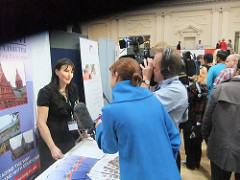When people think of events, they often focus on the opportunities of the day. This can include the ability to attend sessions, network with other professionals, and generate sales leads. But an event can offer much more than what you can see in a day. Businesses and event planners alike can take advantage of the unique opportunities for content production these gatherings provide, allowing for the creation of new marketing materials, sharing the information with those not in attendance, or simply the option to save the information for posterity.
Before you limit your event activities to the live experience, here are some ways you can make the day count for so much more.
Live Streaming
 Not everyone interested in attending an event can make it work. Often, large shows attract potential participants from far and wide, but not every person who would like to attend can manage the cost or time commitment required, especially if the event is held in a city other than their own. And this is where live streaming comes into play.
Not everyone interested in attending an event can make it work. Often, large shows attract potential participants from far and wide, but not every person who would like to attend can manage the cost or time commitment required, especially if the event is held in a city other than their own. And this is where live streaming comes into play.
Livestreaming allows sessions and other activities to be shared with a wider audience, often only requiring the participant to access the feed through a suitable internet browser or companion app. In fact, live streaming plays a significant role in virtual and hybrid events, helping individuals from across the world connect with each other, keynote speakers, presenters, and more.
Additionally, most solutions allow the sessions to be recorded. That means those who can’t attend in-person can enjoy the content at a later time, giving you a potential marketing point to use directly after the event and into the future.
Video Production
Video production takes things in a slightly different direction. While enter sessions can be recorded in their entirety, allowing them to be shared in the future, you also have the option of creating videos with higher production values or for specific purposes.
For example, clips can be compiled with other images to create advertising for specific companies, speakers, products, or the event planners themselves. Or pieces of information that were provided throughout the event can be combined to meet larger learning objectives based on shared topics or interests. Finally, snippets can be used to create materials for news outlets or internal current events pages.
Often, these can be created using footage from with live streams, or they can be recorded independently. This provides companies with a range of options whether they intend to make the materials accessible online or not.
Interviews
 One of the biggest benefits of large events is the networking opportunities they provide. Typically, professionals come together from a range of companies and from outside the local area. When this occurs, you may have the unique chance to interview a professional whom may otherwise be difficult to reach.
One of the biggest benefits of large events is the networking opportunities they provide. Typically, professionals come together from a range of companies and from outside the local area. When this occurs, you may have the unique chance to interview a professional whom may otherwise be difficult to reach.
The value of interviews can be extensive depending on the topics being covered. Additionally, you often have the opportunity to plan questions in advance, ensuring you can request the information you would value most without the risk of it being forgotten.
Further, interviews provide the chance to develop a rapport with other professionals in the field. Since an interview can be conversational in nature, it has the ability to reach new topics of interest organically. And, if the interviewer is open to sharing about themselves, it can create a mutual connection that will serve them well in the future.
Once an interview is complete, it can be turned into other materials for later use. If the interview is recorded, either with simple audio or video, it can be added to other marketing efforts or internal materials. And, regardless of the method used for collecting the responses, it can always be turned into an article.
Articles
Creating an article is one of the most traditional methods for producing materials based on an event. They can be focused on key interviews, as mentioned above, as well as other event happenings. Often, summaries of key sessions make strong articles for later use, as well as reviews of any presented technologies or other business advancements. Direct presentations can also provide valuable information, especially on topics presented by leaders in their fields.
Articles have a wide variety of uses once they are created. They can be maintained for future reference within an organization or can be released to interested news outlets. Further, they can be attached to other marketing materials, such as newsletters, to share with customers or other stakeholders.
How to Create Strong Content
Regardless of your preferred method, creating strong content doesn’t have to be a challenge. Just make sure to understand your goals prior to attending the event, and take the time to get the tools, technologies, or other equipment you need in place to capture the information you need. Then, simply review your materials with your goal in mind, and select the proper pieces to produce the final product.
Often, events provide a wealth of information in a short time, so make sure always to be prepared to record what you need at all times. Then, you won’t be caught off guard no matter where the event takes you.
Catherine Reed
Latest posts by Catherine Reed (see all)
- Increase Your Event’s Social Presence by Creating Photo-Worthy Moments - March 6, 2020
- How to Make the Most of Content Production Opportunities at Events - March 3, 2020
- Is Your WiFi Ready for Live-Streaming? - April 25, 2019

